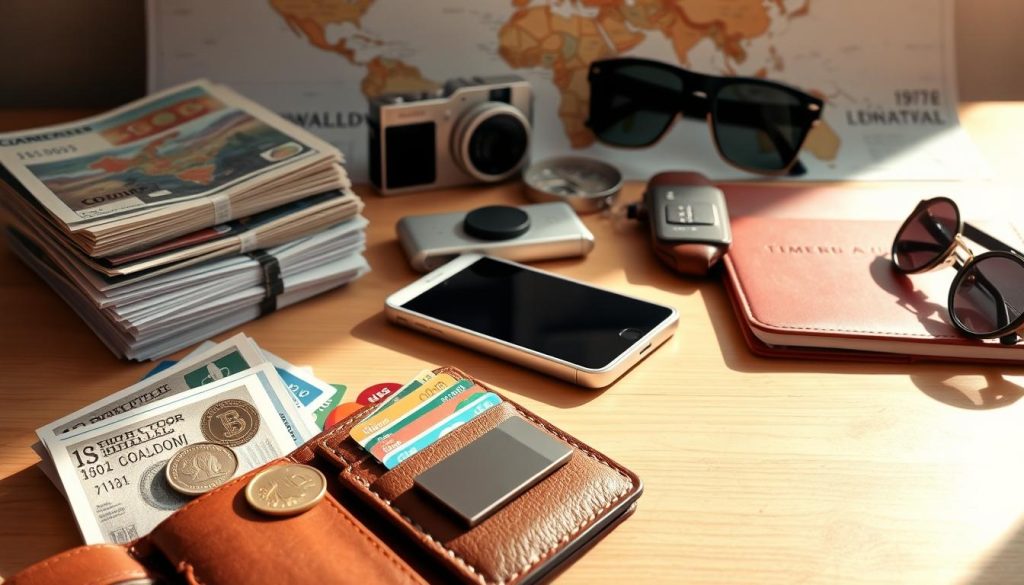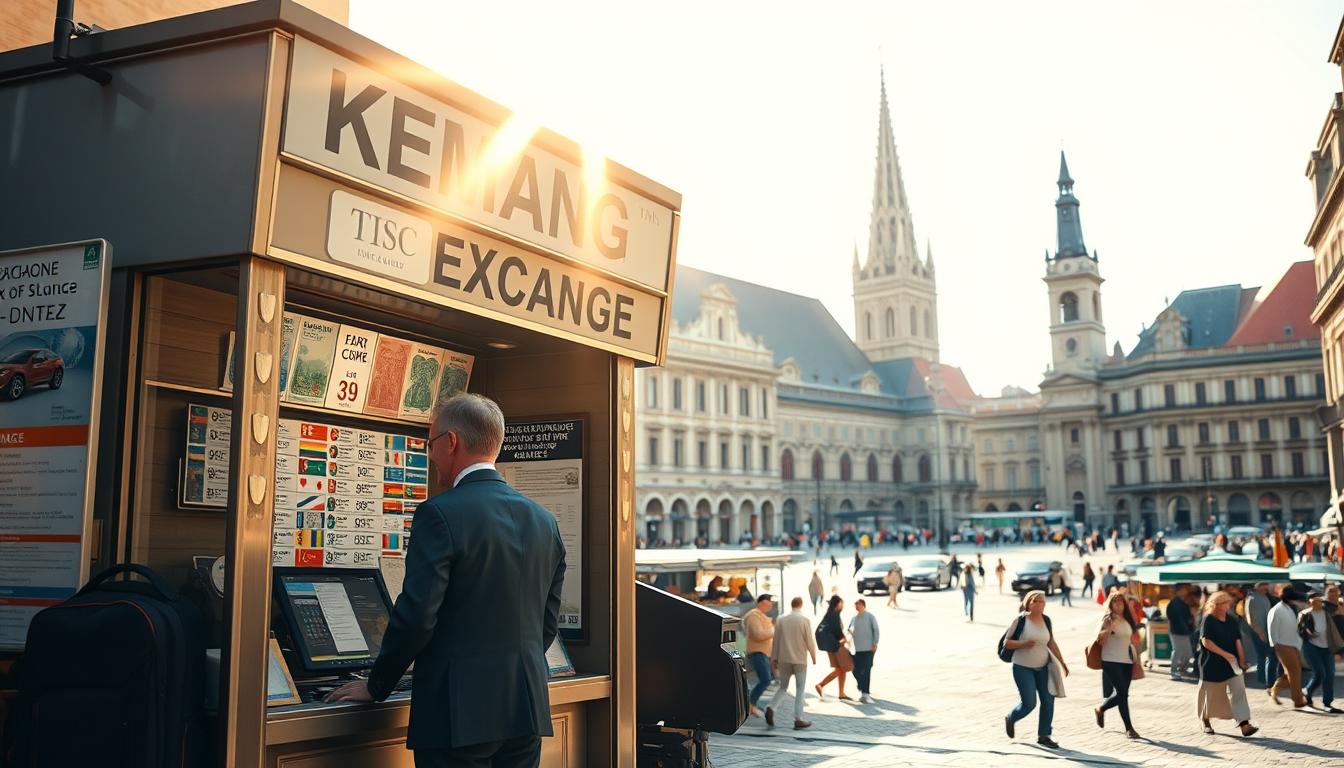When planning your next trip, managing your money wisely can make all the difference. Whether you’re exploring bustling cities or quaint villages, understanding the local currency and payment options is essential for a smooth experience.
In many destinations, the Euro is the official currency, and knowing the mid-market exchange rate can save you from unnecessary fees. This guide will help you navigate everything from cash and card usage to ATM withdrawals, ensuring you get the best value for your money.
From avoiding high transaction fees to choosing the right debit card, we’ve got you covered. Ready to make your trip hassle-free? Let’s dive in!
About Lithuania’s Currency and Payment Landscape
Understanding the local payment system can make your journey smoother. Since 2015, the Euro has been the official currency, replacing the Lithuanian litas. This change has streamlined transactions and made it easier for travelers to manage their money.
Overview of Euro Adoption in Lithuania
Lithuania adopted the Euro in 2015, becoming the 19th member of the eurozone. The fixed exchange rate was set at 3.45280 litas to 1 Euro. This transition has strengthened the local economy and simplified currency exchange for visitors.
Popular Payment Methods: Cash, Cards, and ATMs
When it comes to payments, you have several options. Cash is handy for small purchases, like at local markets or cafes. Most businesses, including restaurants, hotels, and shops, accept card payments. Major credit and debit cards are widely used, making it convenient for travelers.
ATMs are plentiful, especially in cities like Vilnius. They typically operate at the mid-market exchange rate, but some may charge additional fees. To avoid surprises, check with your bank before making ATM withdrawals.
Knowing these payment methods ensures a hassle-free trip. Whether you prefer cash or card, being prepared helps you make the most of your travel experience.
Lithuania: Ultimate Travelers Guide to Currencies & Payments
Handling your finances efficiently can transform your travel experience. This guide is your one-stop resource for managing money in your destination. From currency exchange to secure payment methods, we’ve got you covered.
Being informed about exchange rates and fees can save you money. Whether you prefer cash or card, this guide provides practical tips to minimize costs and maximize value.
We’ll also explore the benefits of using dedicated travel cards. These cards often offer better exchange rates and lower transaction fees, making them a smart choice for frequent travelers.
Here’s a quick comparison of popular travel card options:
| Card Type | Exchange Rate | Fees | Best For |
|---|---|---|---|
| Prepaid Travel Card | Mid-market rate | Low | Budget-conscious travelers |
| Credit Card | Varies | Moderate | Convenience |
| Debit Card | Mid-market rate | Low | ATM withdrawals |
By the end of this guide, you’ll have a clear understanding of how to manage your money effectively. From ATM withdrawals to card payments, we’ll help you navigate every step of your trip.
Preparing for Currency Exchange Before Your Trip
Getting your currency exchange sorted before your trip can save you time and money. By planning ahead, you’ll avoid last-minute stress and unnecessary fees. Whether you’re exchanging dollars to euros or monitoring live rates, preparation is key to a smooth travel experience.
Why Exchange Your Currency Before Departure?
Exchanging your money in advance offers several advantages. First, you’ll likely get a better rate compared to airport kiosks, which often charge higher fees. Having euros on hand when you arrive is also convenient for small transactions, like tipping or buying snacks.
Another benefit is avoiding the hassle of finding a reliable exchange service in a new city. By exchanging at home, you can focus on enjoying your trip instead of worrying about currency issues.
How to Monitor the Mid-Market Exchange Rate
Keeping an eye on the mid-market rate ensures you get the best deal. Websites and apps like Wise or XE provide live updates, helping you make informed decisions. Here’s a quick comparison of exchange options:
| Option | Exchange Rate | Fees | Best For |
|---|---|---|---|
| Local Bank | Mid-market rate | Low | Reliability |
| Airport Kiosk | Marked-up rate | High | Last-minute needs |
| Online Service | Mid-market rate | Low | Convenience |
By monitoring rates and comparing options, you can save money and make the most of your travel budget. Avoid airport exchanges whenever possible, as they often come with hidden costs.
Smart Ways to Manage Money on the Road
Managing your finances effectively while traveling can make your journey stress-free and enjoyable. By using a mix of cash and cards, you’ll have the flexibility to handle any situation. Here are some practical tips to help you stay on top of your money while exploring new places.

Carrying both cash and a reliable card is a smart strategy. Cash is useful for small purchases or in areas where card payments aren’t accepted. On the other hand, cards are convenient for larger expenses and offer better security against theft.
Tracking your expenses in real time is another great way to stay within budget. Mobile banking apps can help you monitor your spending and set daily limits. This ensures you don’t overspend and keeps your travel plans on track.
Here’s a quick comparison of payment methods to help you decide:
| Method | Best For | Fees |
|---|---|---|
| Cash | Small purchases, local markets | None |
| Debit Card | ATM withdrawals, daily expenses | Low |
| Credit Card | Hotels, car rentals | Moderate |
To minimize fees, avoid using ATMs that charge high withdrawal costs. Instead, look for ATMs affiliated with your bank or those that offer low transaction fees. Setting up alerts for exchange rate changes can also help you get the best deal when converting currency.
Finally, always keep emergency funds accessible. Whether it’s a small amount of cash or a backup card, having a safety net ensures you’re prepared for unexpected expenses. With these strategies, you can focus on enjoying your trip without worrying about your money.
Decoding ATM Operations and Fees in Lithuania
Navigating ATM operations in a new country can seem daunting, but with the right knowledge, it’s a breeze. Understanding how ATMs work and the fees involved can save you both time and money during your trip.
ATMs in Lithuania typically offer competitive exchange rates, but fees may apply after free withdrawal limits. To avoid unnecessary costs, it’s essential to ensure you’re charged in euros to bypass dynamic currency conversion.
Finding ATM Locations with Competitive Rates
Locating ATMs with favorable rates is easier than you might think. Major cities like Vilnius and Kaunas have ATMs affiliated with international banks, which often offer better rates and lower fees. Here’s a quick comparison of ATM options:
| ATM Type | Exchange Rate | Fees | Best For |
|---|---|---|---|
| Bank ATMs | Mid-market rate | Low | Reliability |
| Independent ATMs | Marked-up rate | High | Convenience |
| Airport ATMs | Marked-up rate | High | Last-minute needs |
Using bank ATMs is usually the safest and most cost-effective option. They often provide free withdrawals up to a certain limit, making them ideal for daily expenses.
Tips for Safe Debit Card Withdrawals
When withdrawing cash abroad, safety is just as important as cost. Here are some tips to ensure your debit card is used securely:
- Always use ATMs located in well-lit, secure areas, such as inside banks or shopping centers.
- Cover the keypad when entering your PIN to prevent skimming devices from capturing your information.
- Set up transaction alerts on your phone to monitor withdrawals in real time.
“Ensuring you’re charged in euros can save you from unnecessary conversion fees. Always double-check the currency before confirming the transaction.”
By following these steps, you can minimize risks and make the most of your travel money. Planning your withdrawals ahead of time also helps you avoid last-minute stress and high fees.
Navigating Cash and Card Payments at Various Venues
Choosing the right payment method can enhance your travel experience and save you money. Whether you’re dining at a café, shopping at a market, or exploring a new city, knowing when to use cash or a card is essential. This guide will help you make informed decisions and avoid common pitfalls like dynamic currency conversion.

When to Use Cash versus Cards
Cash is often the best option for small, everyday transactions. Local markets, street vendors, and small shops may not accept cards, so having cash on hand is practical. It’s also useful for tipping or paying for public transportation.
On the other hand, cards are ideal for larger purchases like hotel stays or car rentals. They offer better security and often come with benefits like cashback or travel rewards. Most restaurants and stores in urban areas accept major credit and debit cards, making them a convenient choice.
Avoiding Dynamic Currency Conversion
Dynamic currency conversion (DCC) occurs when a merchant offers to charge your card in your home currency instead of the local one. While it might seem convenient, this service often comes with hidden fees and unfavorable exchange rates.
To avoid this, always insist on being charged in the local currency. Check your receipt to ensure the transaction is in euros, not dollars or another currency. Politely decline any offers for DCC to save on unnecessary costs.
Here are some tips for managing your payments effectively:
- Carry a mix of cash and cards for flexibility.
- Verify payment amounts and exchange rates on receipts.
- Use ATMs affiliated with major banks to minimize withdrawal fees.
“Always insist on being charged in the local currency to avoid hidden fees and unfavorable exchange rates.”
By staying aware of your spending habits and choosing the right payment method, you can make the most of your travel money. Whether you prefer cash or cards, being prepared ensures a smooth and enjoyable trip.
Utilizing International Travel Cards Effectively
International travel cards are a game-changer for managing your finances abroad. They offer seamless currency conversion, low fees, and the ability to hold multiple currencies. Whether you’re traveling for business or leisure, these cards simplify your payment process and save you money.
One of the biggest advantages is their competitive exchange rates. Unlike traditional banks, travel cards like Wise and Revolut use the mid-market rate, ensuring you get the best value for your money. They also eliminate hidden fees, making them a cost-effective choice for frequent travelers.
Comparing Top Travel Card Options
When choosing a travel card, it’s essential to compare features like supported currencies, fee structures, and ease of use. Here’s a breakdown of popular options:
| Card | Supported Currencies | Exchange Rate | Fees | Best For |
|---|---|---|---|---|
| Wise | 50+ | Mid-market | Low | Multi-currency transactions |
| Revolut | 30+ | Mid-market | Low | Daily spending |
| Travelex | 10+ | Marked-up | Moderate | Prepaid convenience |
Wise and Revolut stand out for their low fees and multi-currency support. They also offer mobile apps for easy balance management and real-time transaction tracking.
Topping up your card is simple. Most providers allow you to add funds via bank transfer, debit card, or even Apple Pay. This flexibility ensures you’re always prepared for unexpected expenses during your trip.
Here are some tips for choosing the right card:
- Look for cards with no monthly fees or minimum balance requirements.
- Check if the card supports the currencies you’ll use most often.
- Ensure the app provides real-time notifications for every transaction.
“Using a travel card with mid-market exchange rates can save you hundreds of dollars on international trips.”
By selecting the right card and managing it wisely, you can enjoy a stress-free travel experience. Whether you’re withdrawing cash or making purchases, these cards offer the security and convenience you need.
Ensuring Payment Security and Best Practices Abroad
Keeping your finances secure while traveling is essential for a stress-free experience. From protecting your card details to avoiding fraud, taking proactive steps ensures your money stays safe. Here’s how you can safeguard your payments and enjoy your trip without worries.

Protecting Your Card and Personal Information
Start by keeping your card details secure. Always store your cards separately and avoid carrying all of them at once. Make photocopies of your credit card and debit card details, including the emergency contact numbers. This way, you’re prepared if your cards are lost or stolen.
Use secure networks for online transactions. Public Wi-Fi can expose your personal information to hackers. Instead, rely on trusted networks or use a VPN for added security. Mobile banking apps are a great tool for managing your accounts safely while on the go.
Strategies to Prevent Fraud
Fraud can happen anywhere, but being vigilant minimizes the risk. Set up transaction alerts on your phone to receive immediate notifications of any unusual activity. This helps you catch unauthorized charges quickly and take action.
Be cautious when using ATMs. Choose machines located in well-lit, secure areas, like inside banks. Cover the keypad when entering your PIN to prevent skimming devices from capturing your information.
Monitor your account statements regularly. Checking your bank activity in real time ensures you spot suspicious transactions early. If something seems off, contact your bank immediately.
“Always use secure networks for transactions and set up alerts to detect any unauthorized activity. Vigilance is your best defense against fraud.”
By following these tips, you can protect your travel money and focus on enjoying your journey. Staying informed and prepared ensures a smooth and secure experience abroad.
Choosing the Right Currency Exchange Providers
Finding the best place to exchange your money can make a big difference in your travel budget. Whether you’re in a bustling city center or at an airport, understanding the pros and cons of each option helps you save money and avoid unnecessary fees.
City Center Options vs. Airport/Hospitality Venues
City center exchange bureaus often offer better rates compared to those at airports or hotels. This is because they operate in competitive markets, driving down costs. On the other hand, airport and hotel exchanges tend to have higher markups and hidden fees due to their convenience.
For example, a city center provider might offer a rate of 0.90 EUR for 1 USD, while an airport kiosk might charge 0.85 EUR. Over larger amounts, this difference can add up significantly. Always compare rates and read the fine print to avoid surprises.
Tips for Selecting Cost-Effective Providers
Here are some strategies to ensure you get the best deal:
- Research providers in advance using online tools or apps to compare exchange rates.
- Avoid last-minute exchanges at airports or hotels, as they often come with higher costs.
- Look for providers with transparent fee structures and no hidden charges.
Consider using a travel card as an alternative. Cards like Wise or Revolut offer mid-market rates and low fees, making them a cost-effective choice for frequent travelers.
“City center exchanges are your best bet for competitive rates. Always compare options and avoid airport kiosks to save money.”
Comparison of Exchange Providers
| Provider | Exchange Rate | Fees | Best For |
|---|---|---|---|
| City Center Bureau | 0.90 EUR/USD | Low | Competitive rates |
| Airport Kiosk | 0.85 EUR/USD | High | Last-minute needs |
| Travel Card | Mid-market rate | Low | Frequent travelers |
By planning ahead and choosing the right provider, you can maximize your travel money and enjoy a stress-free trip. Whether you prefer cash or cards, being informed ensures you get the best value for your currency.
Additional Travel Money Tips and Tricks
Traveling often comes with surprises, and managing your money wisely can help you handle unexpected costs. Whether it’s a missed flight or an unplanned expense, being prepared ensures you stay on track with your budget. Here are some practical tips to help you adapt your spending strategies on the go.

Budgeting for the Unexpected
Start by setting aside a small emergency fund. This cash reserve should be separate from your main travel budget and used only for unforeseen expenses. It’s also a good idea to keep this money in a secure place, like a hidden pouch or a locked compartment in your bag.
Using travel apps can help you monitor your spending in real time. Apps like Trail Wallet or YNAB allow you to track expenses and adjust your budget as needed. This way, you can avoid overspending and stay prepared for any surprises.
Flexible Payment Methods
Having multiple payment options is key to handling emergencies. Carry a mix of cash, a credit card, and a debit card. Each method has its advantages:
- Cash is useful for small, immediate needs.
- Credit cards offer purchase protection and are ideal for larger expenses.
- Debit cards are great for ATM withdrawals when you need local currency.
If something goes wrong, like a lost card, contact your bank immediately. Most banks offer 24/7 support to block transactions and issue replacements quickly.
Real-World Examples and Solutions
Unexpected costs can range from medical emergencies to transport delays. For instance, if you miss a flight, having a credit card with travel insurance can cover rebooking fees. Similarly, knowing local tipping customs can help you avoid overpaying or offending service providers.
Here’s a quick comparison of payment methods for emergencies:
| Method | Best For | Fees |
|---|---|---|
| Cash | Small, immediate needs | None |
| Credit Card | Large expenses, insurance | Moderate |
| Debit Card | ATM withdrawals | Low |
“Always carry a backup payment method and keep emergency cash separate from your main funds. This ensures you’re prepared for any situation.”
By following these tips, you can handle unexpected expenses with ease and enjoy a stress-free travel experience. Whether it’s a small hiccup or a major issue, being prepared makes all the difference.
Conclusion
Making the most of your trip starts with smart money management. By planning ahead and staying informed about exchange rates and fees, you can save both time and money. Whether you prefer using cash or a card, understanding local practices ensures a seamless experience.
Researching your options, like travel money cards or secure ATMs, can help you avoid unnecessary costs. Always monitor exchange rates and choose providers with transparent fee structures. This way, you’ll get the best value for your money.
With these tips, managing your finances abroad becomes stress-free and cost-effective. Stay prepared, stay informed, and enjoy your journey with confidence. Safe travels!
The above is subject to change.
Check back often to TRAVEL.COM for the latest travel tips and deals.
Here are some Tours & Sightseeing suggestions that might pique your interests!





